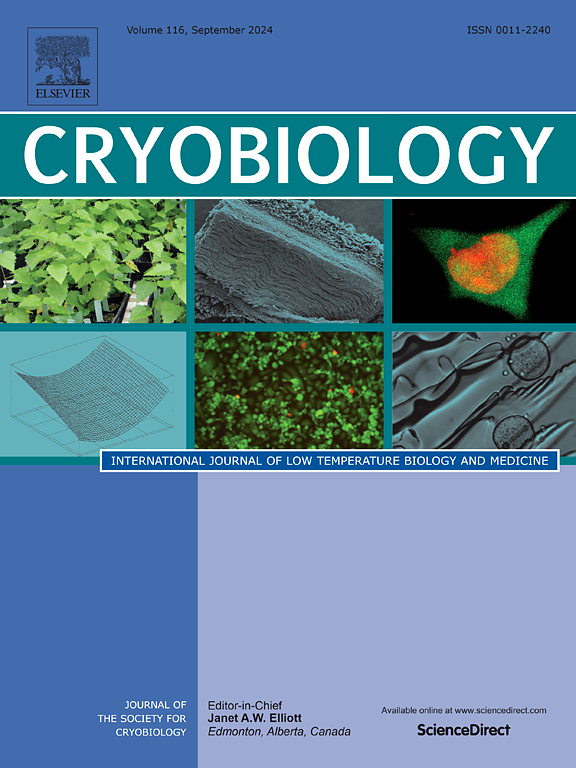Dynamics of amino acids in the shoot tips of Pogostemon yatabeanus during cryopreservation by droplet-vitrification method and its modifications
IF 2.1
3区 生物学
Q2 BIOLOGY
引用次数: 0
Abstract
Cryopreservation offers effective long-term conservation of the endangered plant species with non-orthodox or unavailable seeds. Shoot tips of Pogostemon yatabeanus, an endemic Korean species, were successfully cryopreserved via the optimized droplet-vitrification (DV) method which included 10 % sucrose preculture, osmoprotection with 17.5 % glycerol + 17.5 % sucrose, vitrification solution (33.3 % glycerol + 13.3 % dimethyl sulfoxide + 13.3 % ethylene glycol + 20.1 % sucrose) treatment and cooling-rewarming using aluminum foil strips. Regrowth was performed in three steps, starting with the ammonium-free medium with growth regulators, followed by full-strength medium with and without growth regulators in the second and the third steps. The contents of 17 amino acids (AA) in shoot tips were analyzed using gas-chromatography-mass-spectrometry (GC-MS/MS) at each step of the optimum DV protocol and in the following modifications: excluding or modifying preculture or osmoprotection, varying vitrification solution composition, cooling-rewarming in vials, change of regrowth conditions. In the optimum DV procedure, the total content of AA increased by 20–40 % at preculture and osmoprotection, dropped to 6 % of their level in freshly excised shoot tips after the first five days of regrowth, and raised again after two weeks of recovery. The contents of alanine, glycine, β-alanine, serine, and γ-aminobutyric acid were maximized during osmoprotection and vitrification solution treatments (6.27–29.75-fold compared to untreated control). In particular, alanine showed a 30-fold peak during osmoprotection. Excluding preculture or osmoprotection decreased total and individual AA concentrations by 40–70 %. Meanwhile, a high (25 %) sucrose concentration during preculture increased AA' contents almost twice compared to the optimum protocol. Modifications of vitrification solutions caused 20–30 % variations in AA contents. Therefore, AA metabolism is essential in shoot tips’ response to osmotic and freezing stresses and regeneration
液滴玻璃化法冷冻保存大叶大叶茎尖氨基酸动态及其修饰
低温保存为非正统或不可获得种子的濒危植物物种提供了有效的长期保护。采用优化后的液滴玻璃化法(DV)对韩国特有植物Pogostemon yatabeanus的茎尖进行了低温保存,该方法包括10%蔗糖预培养,17.5%甘油+ 17.5%蔗糖渗透保护,33.3%甘油+ 13.3%二甲基亚砜+ 13.3%乙二醇+ 20.1%蔗糖的玻璃化液处理,铝箔条冷却-再加热。再生分三步进行,首先在无氨培养基中添加生长调节剂,然后在添加和不添加生长调节剂的全强度培养基中进行第二步和第三步。采用气相色谱-质谱联用(GC-MS/MS)分析了芽尖中17种氨基酸(AA)的含量,并对最佳DV方案的每个步骤以及以下修改进行了分析:排除或修改预培养或渗透保护,改变玻璃化溶液组成,瓶内冷却-再加热,改变再生条件。在最佳DV处理下,AA的总含量在预培养和渗透保护阶段增加了20 - 40%,在再生的前5天下降到新鲜茎尖的6%,在恢复2周后再次上升。在渗透保护和玻璃化液处理下,丙氨酸、甘氨酸、β-丙氨酸、丝氨酸和γ-氨基丁酸的含量最高,是未处理对照的6.27 ~ 29.75倍。在渗透保护过程中,丙氨酸表现出30倍的峰值。不包括预培养或渗透保护,总AA浓度和个体AA浓度降低40 - 70%。同时,在预培养过程中,高蔗糖浓度(25%)使AA'含量比最佳培养方案提高了近两倍。玻璃化溶液的改变导致了20 - 30%的AA含量变化。因此,AA代谢在茎尖对渗透和冰冻胁迫的响应和再生中起着至关重要的作用
本文章由计算机程序翻译,如有差异,请以英文原文为准。
求助全文
约1分钟内获得全文
求助全文
来源期刊

Cryobiology
生物-生理学
CiteScore
5.40
自引率
7.40%
发文量
71
审稿时长
56 days
期刊介绍:
Cryobiology: International Journal of Low Temperature Biology and Medicine publishes research articles on all aspects of low temperature biology and medicine.
Research Areas include:
• Cryoprotective additives and their pharmacological actions
• Cryosurgery
• Freeze-drying
• Freezing
• Frost hardiness in plants
• Hibernation
• Hypothermia
• Medical applications of reduced temperature
• Perfusion of organs
• All pertinent methodologies
Cryobiology is the official journal of the Society for Cryobiology.
 求助内容:
求助内容: 应助结果提醒方式:
应助结果提醒方式:


